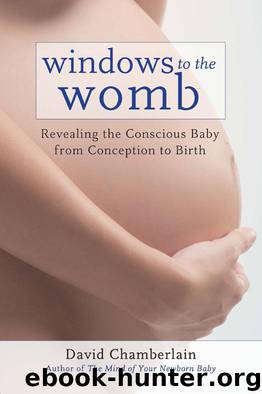Windows to the Womb by David Chamberlain

Author:David Chamberlain
Language: eng
Format: mobi
ISBN: 9781583945698
Publisher: North Atlantic Books
Published: 2013-01-14T21:00:00+00:00
Learning Language in the Womb
How anyone, especially a baby, can learn any of the 6,809 languages used in the world today has never been easy to explain. Today language is appreciated as an instinctive gift of humans, but that doesn’t tell us how babies do it. Experts know that the best time to start learning a language is in the first six years of life after which it becomes increasingly difficult to do so. This could be because the usual way of teaching language in schools via abstract rules of grammar and memorizing long lists of words is the slowest and most painful way to do it. We owe this insight to one of the world’s top linguists of recent times, Professor Paul Pimsler, PhD, who pointed out that the very best possible place to learn a language was in the womb! The secret was curious, relaxed, and repeated listening to favorite voices.
Testing babies in the first year of life has revealed they are superior to older people in their ability to perceive the tiny differences in phonemes, the smallest segments in words. No matter where on earth they are born, babies are interested in the language, accommodate to it, and, with experience, begin to master the complex rules hidden in that language. The earliest evidence of hearing at fourteen weeks conceptional age leaves room for almost six months of fetal listening. Experiments confirm that voices reach the womb in spite of the background noise provided by the mother’s internal organs operating at low sound frequencies. To learn any language, repeated exposure and a receptive brain mean everything. We know this because if a baby has hearing problems, or mothers are mute, language lessons are seriously delayed.
A native language, or mother tongue, springs from the ever-present, cascading sound of mother’s voice heard in utero. Indeed, a mother’s voice is like a favorite toy in utero, so it should not surprise us that experiments with newborn babies reveal that they can identify their mother’s voice from other voices, and prefer to listen to her voice—based on prenatal memory and learning.
Precise research with ultrasound imaging places the earliest sound-making movements of the womb baby at eighteen weeks conceptual age, coming after earliest swallowing at thirteen weeks and earliest respiratory movement at fifteen weeks. The gradual accommodation of the baby’s brain to speech input is the foundation for the first speech output. Verification of these prenatal realities began in the 1960s when new technologies were first used to study the infant cry.
American professor Henry M. Truby, working with colleagues in Sweden at the time, discovered that the developing fetus was receiving and storing speech features transmitted by the mother and was “practicing” in amniotic fluid the neuromuscular gestures that would lead, in air, to the first cries. Studying cry patterns of very premature babies using sound spectrographs—visible portraits of sound packed with thousands of bits of information—resulted in unique records for scientific study, including sound that cannot even be heard by the human ear.
Download
This site does not store any files on its server. We only index and link to content provided by other sites. Please contact the content providers to delete copyright contents if any and email us, we'll remove relevant links or contents immediately.
Name Book, The: Over 10,000 Names--Their Meanings, Origins, and Spiritual Significance by Astoria Dorothy(2938)
Tone Your Tummy Type by Denise Austin(2785)
The Ultimate Guide to Anal Sex for Women by Tristan Taormino(2243)
The Coregasm Workout by Debby Herbenick(2219)
The Expectant Father by Armin A. Brott & Jennifer Ash(2217)
The Women's Health Fitness Fix by Jen Ator(2200)
Expecting Better by Emily Oster(2157)
She-ology by Sherry A. Ross MD(2133)
The Hite Report on Shere Hite by Shere Hite(2021)
Woman: An Intimate Geography by Natalie Angier(1880)
8 Steps to Reverse Your PCOS by Fiona McCulloch(1870)
Birth by Tina Cassidy(1864)
The Female Brain by M.D. Louann Brizendine(1854)
101 Get-Lean Workouts and Strategies by Muscle & Fitness(1807)
Women & the Weight Loss Tamasha by Diwekar Rujuta(1765)
50 Ways to Soothe Yourself Without Food by Susan Albers(1739)
The Big Booty Blueprint: Your Guide To A Bigger Butt In Less Than 12 Weeks by Bella Rahbek & Brandon Carter(1634)
Unleash the Power of the Female Brain: Supercharging Yours for Better Health, Energy, Mood, Focus, and Sex by Daniel G. Amen M.D(1531)
The overachievers by Robbins Alexandra(1528)
